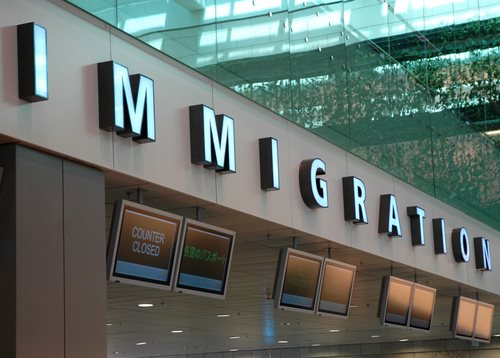
Immigration has been at the forefront of political discourse in the United States for several years. In recent times, the issue has become even more polarizing as the country continues to experience significant demographic changes. Immigration reform is a complicated process that involves several government agencies and policies. In this article, we’ll explore the U.S. immigration and naturalization process in detail, including its history, current policies, and future implications.
History of U.S. Immigration and Naturalization
The United States has always been a nation of immigrants. The country’s foundation was built on the principle of inclusion and diversity, attracting people from all over the world who sought to live the American Dream. Immigration law has long been a contentious issue in the United States. The earliest immigration policy in the country dates back to the late 18th century when the federal government started enacting measures to regulate the entry of foreigners.
The first U.S. immigration laws were passed in 1790, and they focused on three main categories: eligibility, nationality, and financial support. Eligible immigrants were limited to free white persons of good character, excluding slaves and Native Americans. The naturalization process was also restricted to free white persons, excluding African Americans, Native Americans, and most Hispanics.
The Immigration Act of 1924 marked a significant shift in U.S. immigration policy. It introduced a quota system that restricted immigration from certain countries, including Southern and Eastern Europe, Africa, and Asia, while favoring immigrants from Northern and Western Europe. This policy was enacted to preserve the racial and cultural purity of the nation. However, it was abandoned in 1965, when the Hart-Celler Act repealed the quota system and opened the doors to immigrants from all regions of the world.
Current U.S. Immigration Policies
Today, U.S. immigration policies are guided by a set of laws and regulations that aim to promote national security, foreign relations, and economic growth. The U.S. Citizenship and Immigration Services (USCIS) is responsible for implementing these policies and administering immigration benefits and services.
Visa Categories
There are several visa categories for immigrants and non-immigrants, each with its own set of requirements and eligibility criteria. The most common types of non-immigrant visas include:
• Business Visa (B-1)
• Tourist Visa (B-2)
• Student Visa (F-1)
• Exchange Visitor Visa (J-1)
• Temporary Worker Visa (H-1B)
The most common types of immigrant visas include:
• Family-based visas
• Employment-based visas
• Investor and Entrepreneur Visas
These visas allow foreign nationals to reside and work in the United States temporarily or permanently.
Green Card
A Green Card, or Permanent Resident Card, is the document that proves one’s permanent residency status in the United States. It grants the holder the right to live and work in the United States permanently. To obtain a Green Card, a person must qualify for one of the following categories:
• Family-based Green Card
• Employer-sponsored Green Card
• Refugee or Asylum Green Card
However, the Green Card is not achievable by all immigrants. There are some categories of non-immigrants who must return to their home country after a certain period.
Naturalization
Naturalization is the process by which an immigrant becomes a citizen of the United States. To be eligible for naturalization, immigrants must meet the following requirements:
• Be at least 18 years old.
• Be a lawful permanent resident (Green Card holder).
• Have lived continuously in the United States for five years, or three years if married to a U.S. citizen.
• Have no criminal records.
• Have a good moral character.
• Pass an English and civics test.
The naturalization process begins with an application to the USCIS, followed by an interview and exam. Successful applicants are granted U.S. citizenship and are entitled to full rights and privileges, including the right to vote and run for public office.
Immigration Challenges and Controversies
Immigration is one of the most complex and controversial issues facing the United States today. The country’s immigration policies have been a source of controversy for several years, with political leaders sharply divided on how to approach this issue.
The most controversial topic in recent times is the Deferred Action for Childhood Arrivals (DACA). It is the program that allows children who arrived in the United States illegally as minors to apply for temporary protection from deportation. In 2017, the Trump administration officially announced the end of the DACA program. The decision was met with widespread criticism from pro-immigrant groups and advocacy organizations.
Another area of controversy is border security. The U.S.-Mexican border has long been a point of contention, with politicians and citizens alike calling for stricter border controls to prevent illegal immigration. In response, the U.S. government has invested billions of dollars in building barriers and hiring border patrol agents.
Future Implications
The U.S. immigration system is constantly evolving, with new policies and regulations being introduced to address changing circumstances and priorities. Several trends are expected to shape the future of U.S. immigration policy, including:
1. Demographic changes: The United States is becoming increasingly diverse, with minorities projected to become the majority by 2045. This trend is expected to influence immigration policies, making them more inclusive and welcoming to people from different backgrounds.
2. Economic concerns: The United States is facing labor shortages in certain industries, and immigration policies are expected to be reformed to address these concerns. Future immigration policies may place more emphasis on skills and qualifications, prioritizing people who can contribute to the economy.
3. Technology and security: The U.S. government is investing in technology to improve border security and the visa application process. Future immigration policies are expected to include more advanced technology, such as biometric identification and machine learning, to enhance security and efficiency.
Conclusion
U.S. immigration and naturalization are complex processes that involve several government agencies and laws. The United States has a long history of immigration, with immigrants seeking a better life and contributing to the growth of the nation.
Immigration reform is a complex and contentious issue in the United States, and policymakers must navigate competing interests and priorities. However, with proper policies and regulations, the United States can continue to attract and retain the best and brightest from around the world while ensuring national security and promoting economic growth.
The department of U.S. Immigration and Naturalization was once a part of the Department of Justice in the United States. At it’s most basic level, it was the agency that handled cases regarding legalization of citizenship and immigration, as well as issues regarding illegal immigration and working.
However, in 2003 this particular agency was shut down, and new agencies took up the endeavors of the non-existing agency. The U.S. Immigration and Customs Enforcement agency took up the aspects of protection against terrorism, and illegal activity within the borders of the United States. It is responsible for the revamping of particular policies and regulations that go along with border patrol, customs, and other areas of immigration concern.
The citizenship and legalization aspect of the U.S. immigration naturalization office was moved over to what is now the U.S. Citizenship and Immigration Services. This is the agency that deals with all of the legal forms, filing processes, documentation, and review necessary in order to allow individuals to receive citizenship and have their legal rights provide by the government. This agency provides information on the laws that are necessary to know, forms in order to legally become a citizen, and the regulations required with maintaining and upholding citizenship.
U.S. Immigration Services have been instituted with more strict rules and regulations since the attack of the World Trade Center and the Pentagon on September 11, 2001. This is to help protect the citizens of the United States, while presenting individuals of other countries or of varying circumstances the opportunity to formally apply and become a part of this nation.



















